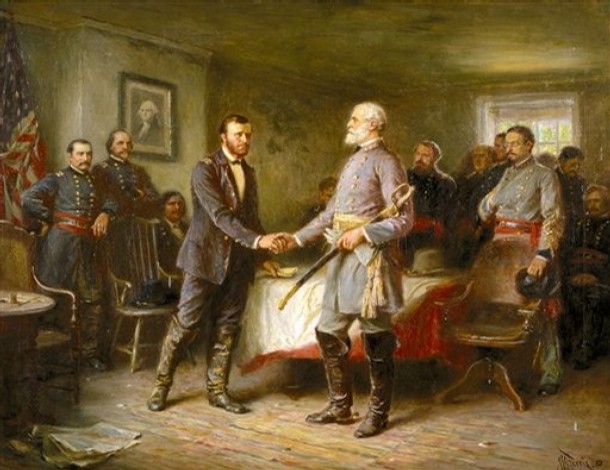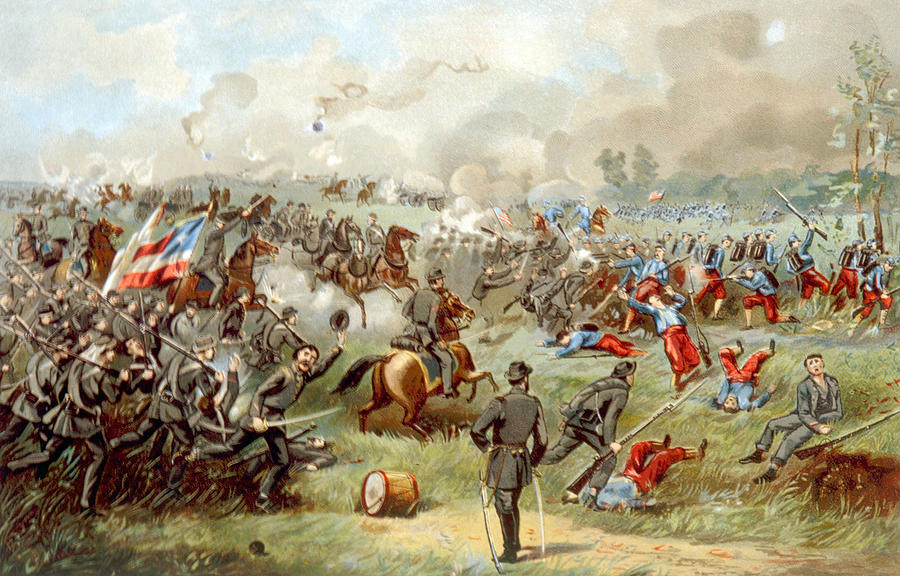 |
| http://www.rampartsofcivilization.com/?__&paged=19 |
Thursday, January 30, 2014
Surrender and immediate aftermath
Andersonville
Andersonville was one of the South's biggest prisons, if not the biggest. The rebel officers would issue small rations for the men, but only once a day. The prisoners had little to look forward to but this. The prisoners also couldn't have much firewood, just some small twigs to heat up and boil food. The prison camp's standards were terrible, and the mortality rate showed this. About to 30-50 northern prisoners died a day. There was very low morality and most men felt deserted because the northerners just left them there. Many died and few survived to be eventually freed at the end of the war.
| https://www.advrider.com/andersonville/now |
Monday, January 27, 2014
Sherman's Atlanta campaign and march to the sea
General Grant, now with a foothold and supply line in Georgia, decided to
send in his friend General Sherman to ravage all of Georgia and South Carolina.
This new battle tactic was to burn and destroy cities, towns, and houses in in
order to demoralize southerners, and want for the war to stop. Not only this,
but it would take away one of the South's crown jewels, Atlanta. They would
tear up the confederate rail lines in Atlanta, and effectively ruin the South’s
rail road complexes. This campaign would also secure Lincoln's reelection
coming up in 1864. After General Sherman secured Atlanta, he burned 30% of it to
stop it from being reused for military purposes, and went away. He continued
this tactic, now called total war, throughout his long march to Savanna. He
claimed Savanna peacefully, only because it immediately surrendered. After
taking Savanna, he continued north into South Carolina, where his men were even
more brutal in his new total warfare tactic.
| http://people.cohums.ohio-state.edu/grimsley1/dialogue/long_shadow.htm |
Chickamauga and Chattanooga and the Union blockade
 |
| http://en.wikipedia.org/wiki/Battle_of_Chickamauga |
Tuesday, January 21, 2014
Gettysburg
By 1863, the Confederacy was slowing down. Farms in
the south were failing because of the increasing amount of escaping slaves and
the fact that it was impossible to export products of high demand with the
Union's blockade of southern ports. Because of this, they also couldn't receive
any, now exhausted, supplies, and because of this soldier’s morale went down
and increasingly deserted the army. Lee hoped that a win in the north could
gain foreign recognition to aid the needy south. On July 1, 1863 the two major
forces met at Gettysburg, Pennsylvania. This proved to be the bloodiest battle
of the war with over 50,000 casualties and deaths. Lee's army was repelled and
retreated to Virginia. It was a major win for the north and it devastated Lee's
already battered army. It was the turning point of the war, and the union
gained the upper hand after that.
 |
| http://froggyradio.com/content/polly-woggs-pond/post/150th-anniversary-battle-gettysburg |
Monday, January 20, 2014
Antietam and the Emancipation Proclomation
After Lee's major victory at the second battle of Bull Run,
he decided to invade the north and get another big victory. If he got this huge
victory, Brittan and France would've recognized the Confederacy as its own country.
And if this happened, than the countries could send extra troops, supplies, and
more to help the south. It would also send a crushing blow to the North’s
morale and war efforts. Unfortunately for him, one of his commanders dropped
Lee's battle plan, and it got picked up by McClellan. He found out that Lee
split his forces and wanted to invade the north. This gave them a huge
advantage. The 2 forces met at Sharpsburg, Maryland in the bloodiest single day
of combat in the entire war. Over 22,000 were either killed or wounded. The confederate
forces were repelled, and McClellan didn't pounce on the rebels to gain ground.
Although it was a tie, it hugely boosted the union soldiers. After this draw,
Lincoln thought it was time to free the slaves. He wanted to wait for the right
time to free them because he was scared that he might lose the Border States,
upset the constitutional rights of the people, and other less important
reasons. He ended up freeing the slaves with his famous Emancipation Proclamation.
He only freed the slaves in the rebelling states to keep the Border States on
his side. It was a momentous decision and it ended up helping the north because
of all the freed slaves that signed up for the north.
| http://thecivilwarparlor.tumblr.com/post/39389925382/150th-anniversary-of-the-battle-of-antietam |
Friday, January 17, 2014
Confederate and union strengnths and weaknesses and first battles
The confederation and union had very diverse economies, strengths, and weaknesses. The union strengths at the time of the civil war were their huge population, strong industries to support the war, blacks to fight with them, railroads, telegrams, a good navy, and more. Their weaknesses included bad generals, the fact that they had to invade the south, and more. The south's strengths included amazing generals, moralized troops defending their homeland, and better armies. Their weaknesses were that they had fewer troops, missed some opportunities to win, were less technologically advanced, had worse weaponry, and more. Although the strengths and weaknesses gave the north a slight advantage, both sides thought themselves superior. Fort Sumpter was a union outpost controlling the Charleston river port. Rebel forces overtook the fort and freed themselves. This angered the northerners and caused many of them to sign up for the war. Many southerners also signed up to "whoop" the northerners. Northern forces met southerners standing at Bull Run creek, which gave it its name. The two forces clashed along this river for a very bloody battle. This demoralized the troops on both sides and gave signs that the war was going to be a long one.
 |
| http://fineartamerica.com/featured/the-battle-of-bull-run-confederate-everett.html |
Monday, January 13, 2014
Election of 1860, secession of Georgia, and Alexander Stephens role.
In 1860 there was the presidential election. Running for office was
northerner and republican Abraham Lincoln and 3 other southerners. Abraham
Lincoln ended up winning even though he did not even get 50 percent of majority
vote. Another obstacle was that 10 southern states didn't even put his name on their
ballot for election. This showed southerners the huge population difference
between the north and south. A big problem for the south was that Lincoln was a
republican, and most likely would take away their biggest strength, slaves. By
the time Lincoln was put into power, 7 southern states had already seceded. In
his inaugural speech he stated that he would reunite the nation. In 1861
Georgia's secession convention took place. As all other southern states voted,
Georgia voted to secede. Unlike other states, it was not unanimous, or even
close to it. Alexander Stephens, a Georgian, was chosen to be the confederacy's
vice president. This is because he originally wanted to stay in the union but
eventually changed his mind. He was there to show his reasoning to other
southerners unsure about the idea. This gave Georgia a big honor in the confederacy.
 |
| http://www.telegraph.co.uk/news/worldnews/northamerica/usa/8319858/Abraham-Lincoln-wanted-to-deport-slaves-to-new-colonies.html |
Dred Scott case
In 1855, a slave and his master moved up north for work. The slave, Dred Scott, worked diligently under his master for 2 full years before a question came into his mind. He was living in the north, where slaves were supposedly free. He ended up trying to sue his master for his freedom in 1857. This case reached the supreme court before a decision was made. The chief justice and other supreme court rulers decided that: no he would not be freed because he was a slave and not a citizen, and only citizens can sue. This angered northerners very much because it officially meant that slavery could exist even where it was outlawed. It also raised a heated public debate on the constitutionality of this ruling.
 |
| http://105.wikispaces.com/Landmark3 |
Saturday, January 11, 2014
Kansas-Nebraska Act
In the 1830's, 40's, and 50's many new states were being admitted into the union. The Kansas-Nebraska territory wanted to join the union too. In 1854, Congress then decided to nullify the 36 30 line rule and allow new states and territories to choose for themselves whether to be slave or free. This scared the north and the abolitionists because it meant slavery could now spread west. In the territories of Kansas and Nebraska, battles were fought over slavery and the nation was once again divided over the issue.
 |
| http://storiesofusa.com/american-civil-war-timeline-battlefields-1854-1865/ |
Compromise of 1850, Fugitive Slave Act, and Georgia Platform
In the late 1840's, gold was discovered in California. Many men, women, and families flocked to California to try their luck. This caused the territory of California to be the fastest growing territory, and soon had enough people to be a state. Unfortunately, it was in the middle of the 36 30 line. The north wanted California to join as a free state, but the south argued that it was partially under the 36 30 line. In the end, a compromise was reached. California was admitted a free state. Texas gave up land and received 10 million dollars for it. The slave market in the capital was abolished. And the south's main goal was given, the fugitive slave act. It required free citizens of the north to help return runaway slaves to their owners in the south, denied jury trials, and created more federal agents to enforce law. This was a huge success for the south. Now any northerner who didn't return escaped slaves could be sued. A major repercussion though was that it bolstered the abolitionist movement. It made the abolitionists angry and redouble their efforts.
 |
| http://tkampra.blogspot.com/2013/03/missouri-compromise-of-1850.html#!/2013/03/missouri-compromise-of-1850.html |
Friday, January 10, 2014
States rights, sectionalism, and nullification
 |
| http://www.socialstudieshelp.com/lesson_29_notes_sec_ho.htm |
Missouri Compromise
In the year of 1820, Missouri wanted to become a slave state of the union. At the time, there was a very delicate balance of senate members in congress between slave and free states. This equality was wanted because if one side gained majority, it could decide the pressing situation of slavery for the whole nation. Northerners didn't want Missouri to be let into the union as a state because it would upset the balance. Southerners, on the other hand, wanted to gain majority in congress with a new slave state's help, Missouri. In the end, a compromise was reached. Missouri would be admitted a slave state, but Massachusetts would be split apart and a new free state would form, Maine. They also decided the 36 30 line rule. It meant that all future states above the line had to be free, and below were to be slave.
 |
| http://www.waymarking.com/waymarks/WM812H_Missouri_Compromise_36_30_Enid_Oklahoma |
Subscribe to:
Posts (Atom)